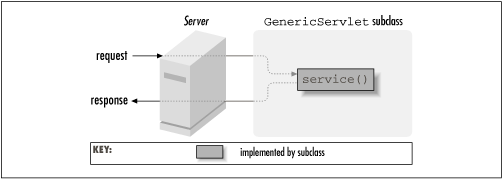
2.2. The Servlet API
Now that you have a basic understanding of HTTP, we can move on and talk about the Servlet API that you'll be using to create HTTP servlets, or any kind of servlets, for that matter. Servlets use classes and interfaces from two packages: javax.servlet and javax.servlet.http . The javax.servlet package contains classes to support generic, protocol-independent servlets. These classes are extended by the classes in the javax.servlet.http package to add HTTP-specific functionality. The top-level package name is javax instead of the familiar java, to indicate that the Servlet API is a standard extension.
Every servlet must implement the javax.servlet.Servlet interface. Most servlets implement it by extending one of two special classes: javax. servlet.GenericServlet or javax.servlet.http.HttpServlet . A protocol-independent servlet should subclass GenericServlet, while an HTTP servlet should subclass HttpServlet, which is itself a subclass of GenericServlet with added HTTP-specific functionality.
Unlike a regular Java program, and just like an applet, a servlet does not have a main() method. Instead, certain methods of a servlet are invoked by the server in the process of handling requests. Each time the server dispatches a request to a servlet, it invokes the servlet's service() method.
A generic servlet should override its service() method to handle requests as appropriate for the servlet. The service() method accepts two parameters: a request object and a response object. The request object tells the servlet about the request, while the response object is used to return a response. Figure 2-1 shows how a generic servlet handles requests.

Figure 2-1. A generic servlet handling a request
In contrast, an HTTP servlet usually does not override the service() method. Instead, it overrides doGet() to handle GET requests and doPost() to handle POST requests. An HTTP servlet can override either or both of these methods, depending on the type of requests it needs to handle. The service() method of HttpServlet handles the setup and dispatching to all the doXXX() methods, which is why it usually should not be overridden. Figure 2-2 shows how an HTTP servlet handles GET and POST requests.

Figure 2-2. An HTTP servlet handling GET and POST requests
An HTTP servlet can override the doPut() and doDelete() methods to handle PUT and DELETE requests, respectively. However, HTTP servlets generally don't touch doHead() , doTrace() , or doOptions() . For these, the default implementations are almost always sufficient.
The remainder in the javax.servlet and javax.servlet.http packages are largely support classes. For example, the ServletRequest and ServletResponse classes in javax.servlet provide access to generic server requests and responses, while HttpServletRequest and HttpServletResponse in javax.servlet.http provide access to HTTP requests and responses. The javax.servlet.http package also contains an HttpSession class that provides built-in session tracking functionality and a Cookie class that allows you to quickly set up and process HTTP cookies.

Copyright © 2001 O'Reilly & Associates. All rights reserved.



